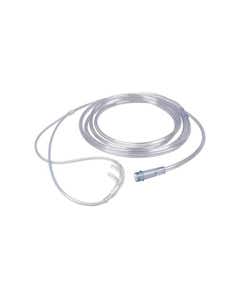

What is High-Flow Oxygen Therapy?
High-flow oxygen therapy is the advanced choice for managing a severe respiratory condition where a low-flow oxygen option is insufficient. Low-flow oxygen therapy is the first step, which may not be sufficient in some cases. High-flow oxygen therapy increases the flow to help patients breathe comfortably daily.
Why is High-Flow Oxygen Therapy Important?
High-flow oxygen is useful to patients who experience excess fluids in their respiratory tract. High-flow oxygen can clear these fluids. High-flow oxygen therapy also reduces airway inflammation and can be more convenient for some patients who want to eat, drink, and communicate during their oxygen therapy.
For many patients with severe respiratory illnesses, high-flow oxygen therapy ensures a manageable daily comfort when it comes to breathing. For patients with chronic obstructive pulmonary disease (COPD), cystitis fibrosis, and other severe respiratory conditions, high-flow oxygen therapy is one treatment that provides ease and comfort.
Other respiratory conditions that are not chronic may also require high-flow oxygen therapy such as severe cases of pneumonia and COVID-19.
What is the Difference Between High-Flow and Regular Oxygen?
Regular or low-flow oxygen therapy provides up to eight liters of oxygen per minute, which is adequate for managing many moderate respiratory illnesses. For more severe respiratory conditions, high-flow delivers between ten to sixty liters of oxygen per minute. High-flow oxygen equipment provides a higher oxygen concentration.
Benefits of High-Flow Oxgen Therapy
Improved Oxygenation
High-flow oxygen therapy provides higher blood oxygen saturation. This increased oxygenation can help patients feel more comfortable and have more energy.
Reduced Need for Invasive Ventilation
High-flow oxygen can also reduce the need for next-step procedures such as intubation or mechanical ventilation. These procedures are sometimes necessary for critical patients when low flow oxygen therapy is no longer sufficient. High-flow oxygen equipment may help the patients avoid these more invasive procedures.
Enhanced Patient Comfort
Overall, high-flow oxygen therapy can help patients cope with their respiratory illness better. High-flow oxygen equipment including a high-flow oxygen nasal cannula, can not only provide higher oxygen saturation levels but also provide a warm, moist flow of oxygen that is more comfortable and helps avoid side effects of dry oxygen.
Better Tolerance for Long-Term Use
For chronic patients like those suffering from COPD, who must depend on oxygen therapy long-term, high-flow oxygen is a consistent and more effective option. Patients can rely on their treatment over an extended period with peace of mind and comfort.
Who Needs High-Flow Oxygen Therapy?
High-flow oxygen is the essential therapy for patients with the most severe respiratory illnesses. Chronic COPD, cystic fibrosis, lung cancer, severe pneumonia, and many chronic respiratory conditions require the higher oxygenation of high-flow oxygen therapy.
What Difference Does High-Flow Oxygen Make?
High-flow oxygen therapy increases the humidification of the oxygen flow, which benefits many types of patients with severe respiratory conditions. More humidity helps prevent dryness in the throat and mouth for some patients. High-flow oxygen may be necessary for oxygen flow to help with healthy blood oxygen levels. In some instances, oxygenation in the blood cannot be reached with low-flow oxygen delivery. High oxygen therapy can enhance those oxygen blood levels.
What Are The Risks Of Having High-Flow Oxygen Therapy?
High-flow oxygen therapy has its risks. Too much pure oxygen can lead to side effects. Dizziness, blurred vision, bloody nose, and sinus problems are all consequences of excess pure oxygen. Doctors need to monitor high-flow oxygen carefully, including oxygen saturation levels in the blood to prevent oxygen poisoning.
How Do I Prepare For High-Flow Oxygen Therapy?
High-flow oxygen therapy is always an option when low-flow oxygen therapy is not raising blood oxygenation to the proper levels. There is no preparation on the part of the patient when a doctor decides to select this therapy. Doctors may evaluate the patient's condition more thoroughly before starting high-flow oxygen therapy. They may use X-rays to view the condition of the patient’s lungs and blood tests to check oxygenation in the blood.
Because of the risks associated with high-flow oxygen therapy, doctors will monitor a patient’s condition very closely to ensure that oxygen poisoning does not occur.
How Does High-Flow Oxygen Therapy Work?
The high-flow nasal cannula delivers a higher rate of oxygen per minute and reduces the flow of air vs. pure oxygen. The higher pure oxygen rate improves overall oxygenation and provides more efficient breathing. The high-flow nasal cannula also delivers warm, humid air which also helps with comfort.
High-flow oxygen concentrators are designed with seven primary components:
- Compressor: draws in ambient air.
- Inlet air filter: filters out particulate matter from entering the oxygen flow.
- Sieve beds: use Zeolite to remove nitrogen from the ambient air to transform it into pure oxygen.
- Humidifier: infuses the oxygen flow with moisture.
- Heated circuits: warms the moist air for comfort.
- Product tank: contains pure oxygen and delivers the oxygen through the hose and high oxygen flow nasal cannula to the patient.
- High-flow oxygen nasal cannula: fits in the patient’s nostrils and delivers warm, moist oxygen at a high rate to maintain normal breathing levels.
What Happens During High-Flow Oxygen Therapy?
During high-flow oxygen therapy, you will breathe through nasal prongs as you sit upright in bed. You will feel a warm sensation as you breathe the high-flow oxygen, and it inflates your lungs. Doctors will set the flow setting of the oxygen depending on your respiratory condition.
What Happens After High-Flow Oxygen Therapy?
After high-flow oxygen therapy, a doctor will monitor blood oxygen levels to determine healthy and stable oxygen saturation. Patients who do not need oxygen therapy long-term, will be weaned off their oxygen by gradually lowering flow levels until the patient has fully recovered. Ongoing follow-up care may ensue to observe respiratory health independent of oxygen therapy.
Medical Uses of High-Flow Oxygen Therapy
High-flow oxygen therapy has valuable benefits beyond therapeutic threat.


Acute Respiratory Failure
High-flow oxygen therapy can act as an effective intervention during acute respiratory failure. During this critical loss of respiration, high-flow oxygen therapy can help restore breathing without the need for more invasive procedures such as mechanical ventilation.
Chronic Obstructive Pulmonary Disease (COPD)
Patients with COPD may experience severe and debilitating instances of incapacitated breathing. High-flow oxygen therapy can help regain healthy oxygenation levels and restore comfortable breathing during these serious episodes.
Postoperative Care and Recovery
High-flow oxygen therapy plays an important role in helping patients recover after surgery. For patients emerging from the operating room for cardiac or thoracic procedures, high-flow oxygen therapy helps keep healthy breathing on track as they recover.
Pediatric and Neonatal Care
High-flow oxygen therapy can help more than adults. The therapy can also assist newborns with respiratory issues in maintaining healthy oxygenation during the critical neonatal period. Children born with asthma and other respiratory conditions can also benefit from the help of high-flow oxygen therapy to stay comfortable during labored breathing episodes.
High-Flow Oxygen Devices and Equipment
All high-flow oxygen devices and equipment provide pure oxygen that is warmed and humidified. High-flow oxygen devices also use nasal prongs for delivering the flow. In some instances, a patient may need high flow away from a medical setting and a high flow oxygen concentrator can be provided for home use.
Best High-Flow Oxygen Nasal Cannulas
The best high-flow oxygen nasal cannulas are comfortable to wear in the nostrils for long periods of time. Longer cannulas allow more flexibility of movement by the user. Most high-flow oxygen cannulas are designed to manage high flow so they may be different than a standard nasal cannula for your home or portable oxygen concentrator.
Where Can I Buy High-Flow Oxygen Concentrators and Supplies?
You can find high-flow oxygen concentrators and supplies at most medical stores. You can also shop online, which allows you to stay at home and compare products side by side. The product you choose can be shipped to your home promptly. Visit The Oxygen Concentrator Supplies Shop for expert help selecting the best high-flow oxygen concentrator equipment for your needs.








